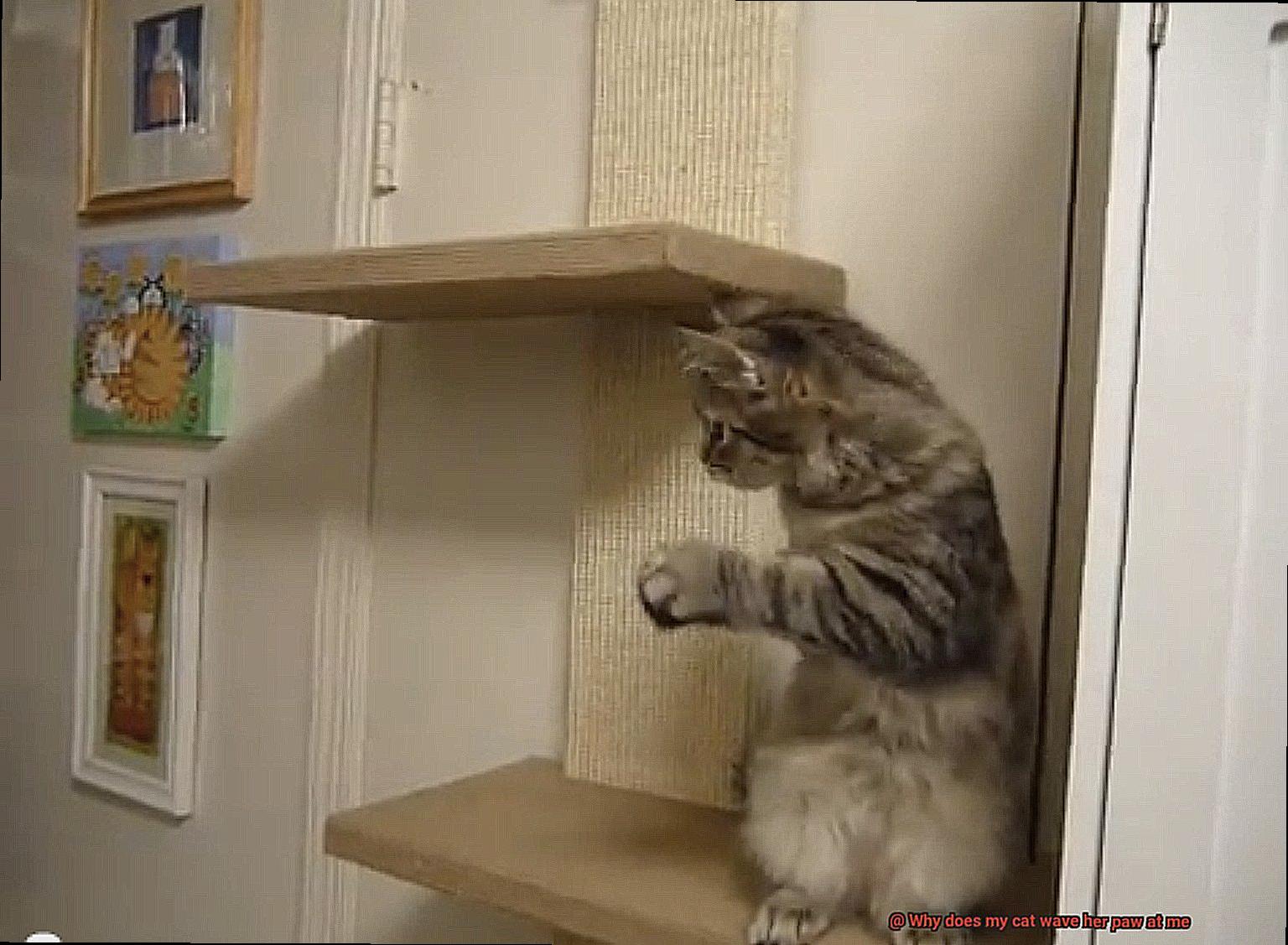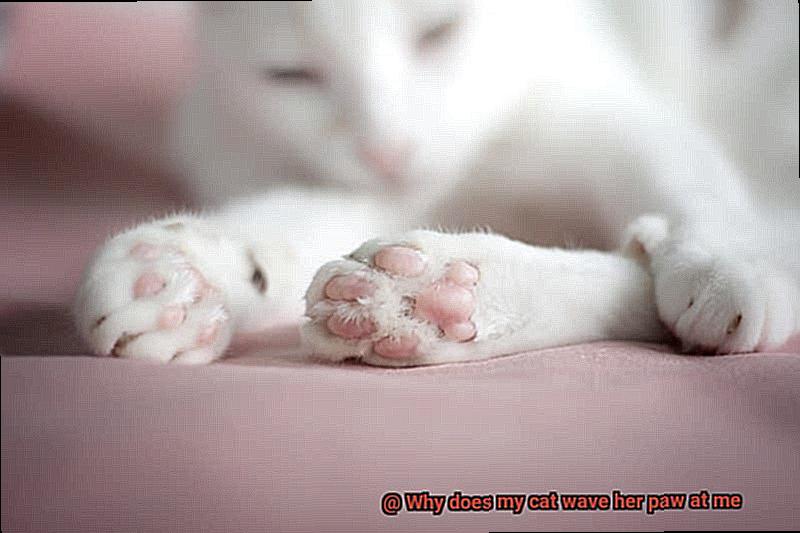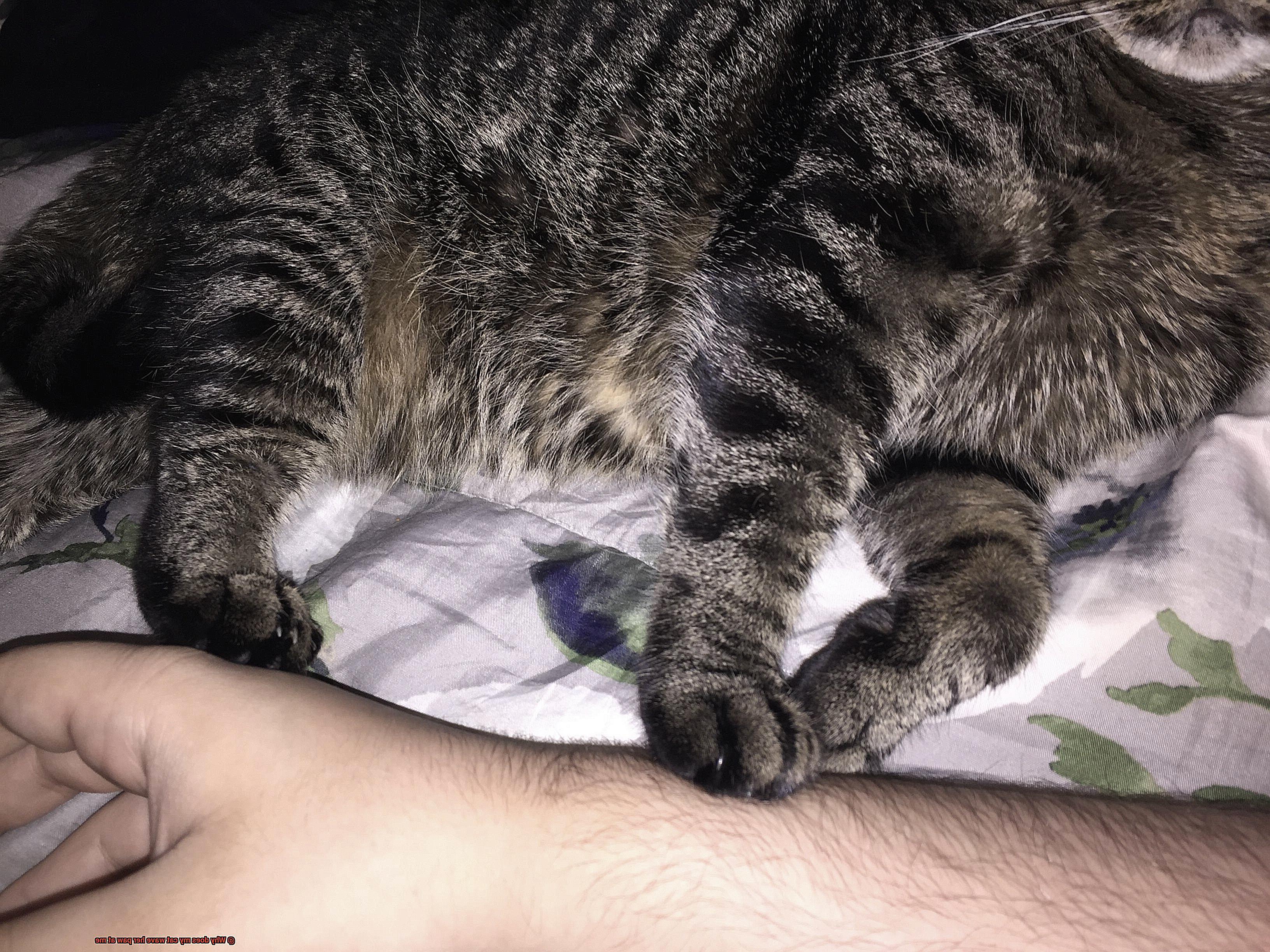Cats are fascinating creatures that have captured our hearts and imaginations for centuries. With their playful antics and quirky behavior, they never fail to keep us on our toes. One such behavior that has left many cat owners scratching their heads is paw waving. Have you ever noticed your furry friend waving her paw at you? If so, you’re probably wondering what it means. Is she trying to tell you something important or is it just a cute feline quirk?
In this blog post, we’ll explore the reasons why cats wave their paws. We’ll uncover the different causes and meanings behind this curious behavior so that you can better understand your cat’s body language and communication style. From friendly greetings to warning signals, we’ll cover all the possible reasons why your cat might be waving her paw at you. Whether you’re a seasoned cat enthusiast or a new cat owner, this post is for you.
So let’s dive in and unlock the secrets behind your cat’s paw waves. By the end of this post, you’ll have a newfound appreciation for your cat’s unique communication skills and body language. Get ready to delve into the fascinating world of feline behavior and decode those mysterious paw signals once and for all.
Reasons Why Cats Wave Their Paws
Cats are fascinating creatures, and one of their quirky behaviors is waving their paws. As a cat owner, you may be left wondering why your feline friend is doing this. Here are five possible explanations for why cats wave their paws:
Greeting
Just like humans wave their hands to greet someone, cats wave their paws as a greeting gesture. When your cat waves their paw at you, it could be a way of saying hello or showing affection. It’s their way of saying “I see you, and I’m happy you’re here.”
Playful Behavior
Cats are playful animals, and waving their paws is sometimes a sign that they want to play with you. They may be inviting you to play with them or trying to initiate a game of tag. This behavior is more common in kittens who are still learning how to hunt and play.
Communication
Cats communicate in many ways, including vocalizations, body language, and gestures such as paw waving. When your cat waves their paw at you, they could be communicating something specific, such as hunger or thirst. It’s essential to pay attention to your cat’s body language and vocal cues to understand what they’re trying to convey.

Marking Territory
Cats are territorial animals, and they use various methods to mark their territory, including paw waving. When your cat waves their paw at you, it could be a way of marking you as part of their territory and showing other cats that you belong to them. It’s their way of saying “this human is mine.”

In conclusion, cats wave their paws for various reasons – seeking attention, greeting, playful behavior, communication, and marking territory. By understanding your cat’s behavior, you can respond appropriately and strengthen your bond with your furry friend.
To Get Attention
Well, wonder no more. Your furry friend is simply seeking your attention, love and affection. Despite their independent nature, cats crave attention just like any other pet. When a cat waves its paw at you, it’s their way of initiating playtime or asking for some cuddles.
However, it’s important to understand that not all paw waves are friendly gestures. Cats may wave their paws as a warning sign when they feel threatened or anxious. This can be a defensive move to protect themselves from perceived danger. As a responsible cat owner, it’s crucial to read your cat’s body language and understand the context of their actions.
To differentiate between a friendly paw wave and a warning sign, pay close attention to your cat’s body language. If they seem relaxed and playful while waving their paw, feel free to indulge them with some attention and affection. However, if your cat seems agitated or fearful while waving their paw, it’s best to give them some space and try to calm them down.
As a Greeting or Acknowledgement
It’s not uncommon for cats to use body language to communicate with their humans. Waving a paw is one way they greet and show affection.
But what motivates cats to wave their paws? Let’s explore some possible reasons:
- Friendly Gesture: Cats can use gestures to greet each other and display affection, and waving a paw at their human can be an extension of this behavior. Next time your cat waves, know that it’s her way of saying “hello” or “I love you.”
- Anticipation: If your cat has learned that waving her paw earns her attention and positive reinforcement, such as pets or treats, she may do it when she’s excited to see you or eager to receive some affection.
- Communication: As masters of body language, cats can use their paws to communicate their mood or needs. If your furry friend seems relaxed while waving her paw, it’s likely just a friendly gesture. But if she appears tense or agitated, she may be trying to tell you something else, like discomfort or fear.
It’s essential to pay attention to your cat’s body language and context when she waves her paw. By doing so, you can better understand what she’s trying to communicate and strengthen your bond with her.
Frustration or Aggression
From their unique vocalizations to their quirky behaviors, cats have a way of communicating with us that’s all their own. One such behavior that many cat owners may have observed is the waving of a paw.
But what does it mean when your cat waves its paw? According to recent research, this gesture can indicate either frustration or aggression. Let’s take a closer look at each of these possibilities.
Frustration is a common emotion experienced by cats, especially when they want something and aren’t getting it. This could be as simple as wanting attention from their owner or as significant as needing food or water. When a cat is experiencing frustration, they may wave their paw in an attempt to communicate their needs. This gesture is often accompanied by meowing or other vocalizations, which serve to reinforce the message they’re trying to convey.
Aggression, on the other hand, is a more serious emotion that can be triggered by a range of situations. When a cat feels threatened or territorial, they may wave their paw in an aggressive manner to ward off perceived intruders. This behavior is often seen when another cat is nearby or when the cat feels that its personal space is being invaded. In addition to waving their paw, cats may also hiss or growl in an attempt to intimidate the perceived threat.
It’s important to note that not all cats will exhibit this behavior, and some may communicate their needs and emotions differently. However, if your cat is waving its paw frequently, it’s worth paying attention to the context and other behaviors that accompany the waving to determine whether it’s a sign of frustration or aggression.
If you suspect that your cat’s waving behavior is due to aggression, it’s best to consult with a veterinarian or animal behaviorist. They can help you identify possible triggers for your cat’s behavior and provide strategies for managing and preventing aggressive episodes.
How to Respond to Your Cat’s Paw Waving
This gesture can have different meanings depending on the context and body language of the cat. As an expert, I have compiled some tips on how to respond to your cat’s paw waving.
Observe the Context
When your cat waves her paw, take note of the context. Is she waving while sitting on your lap, playing with you, or seeking attention? Understanding the context can help you determine what your cat wants from you.
Respond Positively
If your cat is waving her paw in a friendly manner, respond positively by giving her love and attention. Continue petting or cuddling to show her that you appreciate her affection.

Engage in Playtime
If your cat is waving her paw during playtime, it may be a sign that she wants to continue playing or initiate a specific game. Respond by engaging in playtime with her and providing toys or activities that she enjoys.
Provide for Their Needs

Sometimes, your cat may wave her paw as a sign that she needs something. It may be food or water, or it may be time to use the litter box. Respond by providing for her needs and ensuring she has access to food, water, and a clean litter box at all times.
Give Space If Needed
If your cat waves her paw in an aggressive or annoyed manner, take a step back and give her space until she calms down. Trying to engage with an aggressive cat can lead to scratches or bites.
Tips for Understanding Your Cat’s Body Language
This behavior can have various meanings, and interpreting their body language can help you respond appropriately. Here are five sub-sections to help you understand why cats wave their paws and how to interpret their body language cues:
Different Reasons for Paw Waving
Cats wave their paws for a variety of reasons, and it’s not always a sign of aggression. Sometimes, cats wave their paws as a friendly greeting or as a way to get your attention. Other times, it can be a sign of discomfort or fear. Understanding the context of the situation can help you determine why your cat is waving their paw.
Pay Attention to Overall Body Language
When interpreting your cat’s paw waving, it’s essential to look at their overall body language cues. A relaxed and contented cat will have a loose body with an upright tail and forward-pointing ears. An anxious or fearful cat may have a tense body with flattened ears and a tucked tail. These cues can provide additional context for why your cat is waving their paw.
Consider Paw Movement
The movement of your cat’s paw can also provide clues about their intentions. If they’re waving their paw slowly and gently, it could be a sign that they want attention or are trying to initiate playtime. However, if they’re waving their paw quickly or aggressively, it could be a sign that they feel threatened or defensive.
Watch for Other Body Language Cues
In addition to paw waving, cats may display other body language cues such as hissing, growling, or dilated pupils. These cues can help you better understand your cat’s emotional state and respond accordingly.

Respond Appropriately
Once you’ve interpreted your cat’s body language cues, it’s important to respond appropriately. If your cat is waving their paw in a friendly manner, take the time to interact with them and show them some affection. However, if your cat appears agitated or aggressive, give them some space and try to identify the cause of their discomfort.
Socialization and Trauma in Cats

This seemingly harmless behavior can actually be a sign of anxiety or fear, which can stem from socialization and trauma issues.
Socialization is crucial during a kitten’s developmental period. By exposing them to different people, animals, and environments, we help them become well-adjusted and comfortable with human interaction. Kittens who are not adequately socialized are more likely to develop anxiety or fear towards their owners, which can lead to unusual behaviors such as paw waving.
Trauma can also contribute significantly to a cat’s behavior. Negative experiences like abuse or neglect can cause anxiety and fear towards humans, leading to unusual behaviors like paw waving. In such cases, paw waving could be the cat’s way of seeking attention or expressing discomfort.

As responsible pet owners, we must understand that cats communicate through body language. Paw waving could be a sign of greeting or a request for attention, but if accompanied by hissing or growling, it could indicate aggression or fear.
Creating a safe and secure environment is crucial to help your cat feel more comfortable and less anxious. Positive interactions with toys and treats can also help build trust between you and your cat. Seeking the help of a professional animal behaviorist may be necessary in severe cases of trauma to address underlying issues.
The Benefits of Interacting with Your Cat
This gesture can mean different things depending on the context, but one thing is for sure: interacting with your cat is crucial for both their physical and mental health.
Firstly, spending time with your cat strengthens the bond between you two. Cats are social animals who crave attention and affection from their owners. By giving them the love and attention they deserve, you show them that they are valued members of your family. This bond is essential for both the cat and the owner’s emotional well-being.
Furthermore, interactive playtime can provide much-needed exercise for cats. Many felines are prone to obesity and other health issues if they do not get enough physical activity. Playtime with their owner can help them burn off excess energy and stay in shape. This exercise can also prevent boredom and destructive behavior.
Playing with a cat can also be a great stress reliever for both parties involved. Petting a cat has been shown to lower blood pressure and reduce anxiety, making it a relaxing activity for both humans and felines alike. Additionally, interactive playtime can provide mental stimulation for cats, which is essential for their cognitive development.
So how can you interact with your cat? Well, there are many ways. You can play with them using toys like laser pointers or feather wands, groom them with a brush or comb, or simply cuddle up on the couch for some quality bonding time. Whatever activity you choose, make sure it is safe and enjoyable for both you and your cat.
The Importance of Paying Attention to Your Cat’s Signals
One of the most common gestures that cats use is often misunderstood: waving their paw.
While many cat owners may interpret this as a friendly greeting or request for attention, waving a paw can mean much more than that. Understanding these signals is essential to building a strong and healthy relationship with your furry companion.
Here are some reasons why paying attention to your cat’s signals is important:
Territorialism
Cats are territorial animals. Waving their paw could be a way for them to claim ownership over a person or object. It’s important to recognize this signal to avoid invading your cat’s personal space and causing them to feel threatened or anxious.
Frustration and aggression

Sometimes, waving a paw could be a sign of frustration or aggression. If you notice your cat waving its paw in this way, it’s best to back off and give them some space. This could prevent them from lashing out in a more aggressive manner.
Communication of specific needs
Waving a paw may also indicate that your cat needs something specific from you. It could be food, water, or attention. By paying attention to these signals, you can ensure that you’re meeting your cat’s needs effectively.

When to Seek Professional Help for Your Cat’s Behavior
Excessive or concerning paw waving behavior could be a sign of deeper behavioral problems. If you notice any worrying signs, it’s essential to seek professional help.
There are several reasons why you should take your cat’s paw waving seriously. Firstly, if it’s accompanied by other troublesome behaviors, such as aggression towards people or other pets, inappropriate elimination, or destructive behavior, it could indicate underlying medical issues or behavioral problems. A veterinarian or animal behaviorist can assess the situation and provide appropriate interventions to correct these behaviors.

Secondly, if your cat’s paw waving is causing harm to themselves or others, it’s crucial to seek professional help immediately. For example, if your cat uses their paws to scratch at furniture or people, this can cause damage and injury. A professional can identify the root cause of this behavior and provide solutions to redirect it in a more positive way.
Lastly, if you’re feeling overwhelmed or frustrated with your cat’s behavior, seeking professional help is vital to manage the situation effectively. A veterinarian or animal behaviorist can provide you with the tools and resources necessary to improve your relationship with your cat and create a more harmonious home environment.
eRTurgloNn4″ >
Also Read: Why Does Your Cats Stare At The Ceiling?
Conclusion
In conclusion, when your cat waves her paw at you, it could be a sign of affection or a request for attention.
It’s important to pay attention to your cat’s body language and vocalizations to understand their needs and desires. While some cats may wave their paws as a playful gesture, others may do so out of frustration or anxiety.
By observing your cat’s behavior and responding appropriately, you can strengthen the bond between you and your furry companion.







